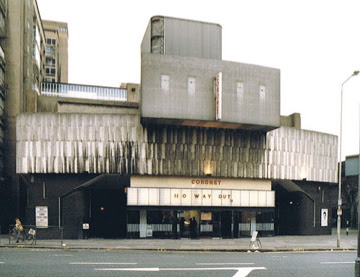Archive for the ‘Elephant and Castle’ Category
Protected: Teddy Boys, Christmas Humphreys and the murder of John Beckley on Clapham Common in 1953
Wednesday, July 20th, 2011Elephant And Castle, Teddy Boys and Tommy Steele
Saturday, October 20th, 2007
‘The Elephant was not exactly a classy district.’

The Elephant was not exactly a classy district. The streets were as rough and dangerous as it was possible to get without anybody actually declaring war, and even the cinema was not without its perils. (Michael Caine)
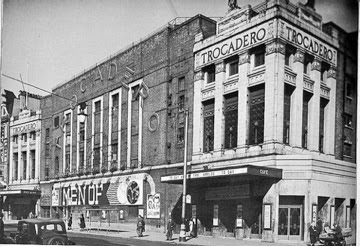
The Trocadero Theatre at Elephant And Castle was built in 1930 and had 3400 seats but by the 1950s the theatre was renowned for its critical and violent local Teddy Boy audience who threw coins at Cliff Richard and jeered Bobby Darin but idolised Duane Eddy. When the film Rock Around The Clock played there, the Teds famously slashed the seats, rioted in the aisles and two policemen were seriously injured when the ‘juvenile deliquents’ let off steam after watching the film. The incidents made headline news. They also loved Buddy Holly who actually made his UK debut at the cinema and concert hall (strangely with Des O’Connor as the compere) in March 1958.
Elephant And Castle, like a lot of South London, had been heavily bombed in the Second World War (most of the damage occurring over just two nights in 1941) and for over a decade the streets, where once music halls, brothels, pubs and tightly-packed terraced houses had stood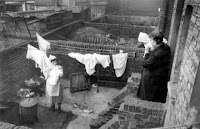 , now lay desolate and dilapidated. From this grim and desperate south London district a new phenomenon grew, The Teddy Boys – Britain’s first youth cult. Their style was derived from Savile Row tailors who had revived the Edwardian look after the war, ironically for upper-class ex-army officers wanting a dandyish look, however the fashion was quickly taken up by teenagers in and around Elephant And Castle in the early fifties and the name given to the followers of the fashion movement soon got corrupted to ‘Ted’ or ‘Teddy Boy’. They wore long drape jackets, usually with a velvet trim collar and pocket flaps, high-waisted drainpipe trousers, chunky brogues and later large crepe-soled shoes (known as brothel creepers), white shirts and narrow ‘Slim Jim’ ties. These clothes were mostly tailor-made at great expense and paid for through many weekly installments. The Teddy Girls meanwhile also wore drape jackets but with hobble skirts (these are narrow at the hem and thus ‘hobble’ the wearer) or toreador pants, cameo brooches, and espadrilles. It was possibly the first example of a sartorial protest against authority and post-war austerity and, realistically, the beginning of the British teenager.
, now lay desolate and dilapidated. From this grim and desperate south London district a new phenomenon grew, The Teddy Boys – Britain’s first youth cult. Their style was derived from Savile Row tailors who had revived the Edwardian look after the war, ironically for upper-class ex-army officers wanting a dandyish look, however the fashion was quickly taken up by teenagers in and around Elephant And Castle in the early fifties and the name given to the followers of the fashion movement soon got corrupted to ‘Ted’ or ‘Teddy Boy’. They wore long drape jackets, usually with a velvet trim collar and pocket flaps, high-waisted drainpipe trousers, chunky brogues and later large crepe-soled shoes (known as brothel creepers), white shirts and narrow ‘Slim Jim’ ties. These clothes were mostly tailor-made at great expense and paid for through many weekly installments. The Teddy Girls meanwhile also wore drape jackets but with hobble skirts (these are narrow at the hem and thus ‘hobble’ the wearer) or toreador pants, cameo brooches, and espadrilles. It was possibly the first example of a sartorial protest against authority and post-war austerity and, realistically, the beginning of the British teenager.
 , now lay desolate and dilapidated. From this grim and desperate south London district a new phenomenon grew, The Teddy Boys – Britain’s first youth cult. Their style was derived from Savile Row tailors who had revived the Edwardian look after the war, ironically for upper-class ex-army officers wanting a dandyish look, however the fashion was quickly taken up by teenagers in and around Elephant And Castle in the early fifties and the name given to the followers of the fashion movement soon got corrupted to ‘Ted’ or ‘Teddy Boy’. They wore long drape jackets, usually with a velvet trim collar and pocket flaps, high-waisted drainpipe trousers, chunky brogues and later large crepe-soled shoes (known as brothel creepers), white shirts and narrow ‘Slim Jim’ ties. These clothes were mostly tailor-made at great expense and paid for through many weekly installments. The Teddy Girls meanwhile also wore drape jackets but with hobble skirts (these are narrow at the hem and thus ‘hobble’ the wearer) or toreador pants, cameo brooches, and espadrilles. It was possibly the first example of a sartorial protest against authority and post-war austerity and, realistically, the beginning of the British teenager.
, now lay desolate and dilapidated. From this grim and desperate south London district a new phenomenon grew, The Teddy Boys – Britain’s first youth cult. Their style was derived from Savile Row tailors who had revived the Edwardian look after the war, ironically for upper-class ex-army officers wanting a dandyish look, however the fashion was quickly taken up by teenagers in and around Elephant And Castle in the early fifties and the name given to the followers of the fashion movement soon got corrupted to ‘Ted’ or ‘Teddy Boy’. They wore long drape jackets, usually with a velvet trim collar and pocket flaps, high-waisted drainpipe trousers, chunky brogues and later large crepe-soled shoes (known as brothel creepers), white shirts and narrow ‘Slim Jim’ ties. These clothes were mostly tailor-made at great expense and paid for through many weekly installments. The Teddy Girls meanwhile also wore drape jackets but with hobble skirts (these are narrow at the hem and thus ‘hobble’ the wearer) or toreador pants, cameo brooches, and espadrilles. It was possibly the first example of a sartorial protest against authority and post-war austerity and, realistically, the beginning of the British teenager.
PHOTOS REMOVED BY REQUEST FROM THE COPYRIGHT OWNER
small versions of the Ken Russell pictures here
Truly excellent photos of Teddy girls and boys from the mid-fifties by the director Ken Russell
The self-styled ‘King of the Teds’ in the late fifties was Eddie Richardson, brother of the future South London gang leader Charlie Richardson.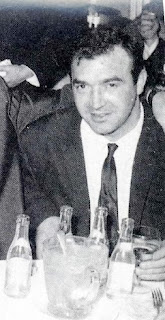 The Richardsons were soon to become infamous for their rivalry with the East London Kray Twins but also for their sadistic methods of torture they dealt out to their enemies. These included being nailed to the floor, teeth being pulled out by pliers (the speciality of their fellow gang member ‘Mad’ Frankie Fraser) and being electrocuted to unconsciousness. However the Richardsons were just part of the local tradition and there had been a history of violence in this part of South London for centuries – even the word ‘hooligan’ (according to the Oxford English Dictionary) comes from ‘a 19th century Irish family in south-east London conspicuous for its ruffianism’. The original Hooligan was apparently a Limerick-born Patrick Hooligan (originally Houlihan) and his family who specialised in street violence in the mid Victorian era. By the beginning of the 20th century Elephant And Castle and its surrounding area was perhaps the most lawless part of the capital. The main gang of criminals, led by Charles ‘Wag’ McDonald, were the so-called Elephant Boys. However while the men were heavily involved in protection rackets and organised violence, the local women were experts at shoplifting. A woman known as Aggy Hill, known as the ‘Queen of the Forty Elephants’, and her associates (presumably some of the Elephants, but did anyone call them that to their faces?) would descend on the West End in chauffeured-driven cars and fleece the shops while their cars waited outside. Of course there were no double yellow lines, officious traffic wardens and parking meters to disrupt the stealing.
The Richardsons were soon to become infamous for their rivalry with the East London Kray Twins but also for their sadistic methods of torture they dealt out to their enemies. These included being nailed to the floor, teeth being pulled out by pliers (the speciality of their fellow gang member ‘Mad’ Frankie Fraser) and being electrocuted to unconsciousness. However the Richardsons were just part of the local tradition and there had been a history of violence in this part of South London for centuries – even the word ‘hooligan’ (according to the Oxford English Dictionary) comes from ‘a 19th century Irish family in south-east London conspicuous for its ruffianism’. The original Hooligan was apparently a Limerick-born Patrick Hooligan (originally Houlihan) and his family who specialised in street violence in the mid Victorian era. By the beginning of the 20th century Elephant And Castle and its surrounding area was perhaps the most lawless part of the capital. The main gang of criminals, led by Charles ‘Wag’ McDonald, were the so-called Elephant Boys. However while the men were heavily involved in protection rackets and organised violence, the local women were experts at shoplifting. A woman known as Aggy Hill, known as the ‘Queen of the Forty Elephants’, and her associates (presumably some of the Elephants, but did anyone call them that to their faces?) would descend on the West End in chauffeured-driven cars and fleece the shops while their cars waited outside. Of course there were no double yellow lines, officious traffic wardens and parking meters to disrupt the stealing.
 The Richardsons were soon to become infamous for their rivalry with the East London Kray Twins but also for their sadistic methods of torture they dealt out to their enemies. These included being nailed to the floor, teeth being pulled out by pliers (the speciality of their fellow gang member ‘Mad’ Frankie Fraser) and being electrocuted to unconsciousness. However the Richardsons were just part of the local tradition and there had been a history of violence in this part of South London for centuries – even the word ‘hooligan’ (according to the Oxford English Dictionary) comes from ‘a 19th century Irish family in south-east London conspicuous for its ruffianism’. The original Hooligan was apparently a Limerick-born Patrick Hooligan (originally Houlihan) and his family who specialised in street violence in the mid Victorian era. By the beginning of the 20th century Elephant And Castle and its surrounding area was perhaps the most lawless part of the capital. The main gang of criminals, led by Charles ‘Wag’ McDonald, were the so-called Elephant Boys. However while the men were heavily involved in protection rackets and organised violence, the local women were experts at shoplifting. A woman known as Aggy Hill, known as the ‘Queen of the Forty Elephants’, and her associates (presumably some of the Elephants, but did anyone call them that to their faces?) would descend on the West End in chauffeured-driven cars and fleece the shops while their cars waited outside. Of course there were no double yellow lines, officious traffic wardens and parking meters to disrupt the stealing.
The Richardsons were soon to become infamous for their rivalry with the East London Kray Twins but also for their sadistic methods of torture they dealt out to their enemies. These included being nailed to the floor, teeth being pulled out by pliers (the speciality of their fellow gang member ‘Mad’ Frankie Fraser) and being electrocuted to unconsciousness. However the Richardsons were just part of the local tradition and there had been a history of violence in this part of South London for centuries – even the word ‘hooligan’ (according to the Oxford English Dictionary) comes from ‘a 19th century Irish family in south-east London conspicuous for its ruffianism’. The original Hooligan was apparently a Limerick-born Patrick Hooligan (originally Houlihan) and his family who specialised in street violence in the mid Victorian era. By the beginning of the 20th century Elephant And Castle and its surrounding area was perhaps the most lawless part of the capital. The main gang of criminals, led by Charles ‘Wag’ McDonald, were the so-called Elephant Boys. However while the men were heavily involved in protection rackets and organised violence, the local women were experts at shoplifting. A woman known as Aggy Hill, known as the ‘Queen of the Forty Elephants’, and her associates (presumably some of the Elephants, but did anyone call them that to their faces?) would descend on the West End in chauffeured-driven cars and fleece the shops while their cars waited outside. Of course there were no double yellow lines, officious traffic wardens and parking meters to disrupt the stealing.The Teds pre-dated American rock and roll but they grew to love the rebellious aspect of this new musical fashion, and this part of South London in one way or another produced many of the British stars that were coming to prominence at the time, basically copying their US conterparts. Terry Dene was born above a sweet-shop in Lancaster Road (a street long since bulldozed and demolished) in Elephant And Castle in 1938. 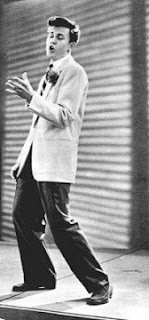 He started playing at the famous Two I’s coffee bar where the influential producer Jack Good spotted him and signed him for popular music television show Six Five Special. His first release was A White Sports Coat which was an instant hit but he found the looming stardom, which seemed to his for the taking, hard to cope with and he was arrested for being drunk and disorderly and the popular press attacked him – the establishment at the time blamed ‘evil’ rock and roll music for seemingly all of society’s ills. It led to a nervous breakdown and his mental health only deteriorated when he started National Service and because of this he was soon discharged after only two months. This time the headlines were even worse as the press presumed he was just trying to avoid conscription. His career was now in ruins, and although he appeared in a film ‘The Golden Disc’ and joined the talent-spotter Larry Parnes’ stable of stars, he was unable to recapture the momentum and faded from the music scene. There were several unsuccessful comebacks and in 1974 he released a book and album entitled ‘I Thought Terry Dene Was Dead’, unfortunately it didn’t really make any difference and the majority of people presumably thought he still was.
He started playing at the famous Two I’s coffee bar where the influential producer Jack Good spotted him and signed him for popular music television show Six Five Special. His first release was A White Sports Coat which was an instant hit but he found the looming stardom, which seemed to his for the taking, hard to cope with and he was arrested for being drunk and disorderly and the popular press attacked him – the establishment at the time blamed ‘evil’ rock and roll music for seemingly all of society’s ills. It led to a nervous breakdown and his mental health only deteriorated when he started National Service and because of this he was soon discharged after only two months. This time the headlines were even worse as the press presumed he was just trying to avoid conscription. His career was now in ruins, and although he appeared in a film ‘The Golden Disc’ and joined the talent-spotter Larry Parnes’ stable of stars, he was unable to recapture the momentum and faded from the music scene. There were several unsuccessful comebacks and in 1974 he released a book and album entitled ‘I Thought Terry Dene Was Dead’, unfortunately it didn’t really make any difference and the majority of people presumably thought he still was.
 He started playing at the famous Two I’s coffee bar where the influential producer Jack Good spotted him and signed him for popular music television show Six Five Special. His first release was A White Sports Coat which was an instant hit but he found the looming stardom, which seemed to his for the taking, hard to cope with and he was arrested for being drunk and disorderly and the popular press attacked him – the establishment at the time blamed ‘evil’ rock and roll music for seemingly all of society’s ills. It led to a nervous breakdown and his mental health only deteriorated when he started National Service and because of this he was soon discharged after only two months. This time the headlines were even worse as the press presumed he was just trying to avoid conscription. His career was now in ruins, and although he appeared in a film ‘The Golden Disc’ and joined the talent-spotter Larry Parnes’ stable of stars, he was unable to recapture the momentum and faded from the music scene. There were several unsuccessful comebacks and in 1974 he released a book and album entitled ‘I Thought Terry Dene Was Dead’, unfortunately it didn’t really make any difference and the majority of people presumably thought he still was.
He started playing at the famous Two I’s coffee bar where the influential producer Jack Good spotted him and signed him for popular music television show Six Five Special. His first release was A White Sports Coat which was an instant hit but he found the looming stardom, which seemed to his for the taking, hard to cope with and he was arrested for being drunk and disorderly and the popular press attacked him – the establishment at the time blamed ‘evil’ rock and roll music for seemingly all of society’s ills. It led to a nervous breakdown and his mental health only deteriorated when he started National Service and because of this he was soon discharged after only two months. This time the headlines were even worse as the press presumed he was just trying to avoid conscription. His career was now in ruins, and although he appeared in a film ‘The Golden Disc’ and joined the talent-spotter Larry Parnes’ stable of stars, he was unable to recapture the momentum and faded from the music scene. There were several unsuccessful comebacks and in 1974 he released a book and album entitled ‘I Thought Terry Dene Was Dead’, unfortunately it didn’t really make any difference and the majority of people presumably thought he still was.Just ten minutes walk away from ‘The Elephant’ on the Waterloo Road was a cafe called The Cave (so-called because it was under some railway arches). Three young musicians played there in a skiffle group called The Cavemen and named after the cafe. They were Lionel Bart, local boy Tommy Hicks and Mike Pratt. They’d all met at a party at a sort of pre-hippie Beatnik commune called The Yellow Door next to The Cave and over six or seven months they played at coffee shops and cafes around town for up to ten shillings a night. They slowly started finding an audience especially at the Two I’s cafe in Soho where they was spotted by the impresario Larry Parnes who re-christened Hicks ‘Tommy Steele’. Decca Records signed Steele in 1956 and in October the trio recorded ‘Rock With The Caveman’ with the help of some British jazz notables including saxman Ronnie Scott. It became the now solo Steele’s first UK hit. A year later the song ‘Handful Of Songs’ which came from the film soundtrack of ‘The Tommy Steele Story’ (released in 1957 and incredibly made in three weeks) and written by Bart, Hicks and Pratt went on to win a Ivor Novello award for the best song.
Tommy Steele soon became a huge success albeit more as an all round family entertainer than a rock and roll star. Lionel Bart went on to write Living Doll – the massive Cliff Richard hit and of course was the writer of the hugely successful musical Oliver! – incidentally Bart couldn’t read or write a note of music and he could barely plonk out a tune with one finger on a piano – so he wrote all his famous songs by humming his tunes into a tape recorder. Mike Pratt, before dying of lung cancer in 1976, eventually went on to strangle Roger Moore in The Saint, gave Patrick McGoohan a severe beating in Danger Man and was the villainous Simey in The Adventures of Black Beauty, but his famous role was when he played Jeff Randall in the fantastic sixties series Randall And Hopkirk (Deceased).
The Trocadero was demolished in 1963 as part of the huge sixties rebuilding of Elephant And Castle. During the previous decade there had been calls to regenerate the violent and filthy district, and in September 1959 ambitious plans to redevelop the area with a shopping centre and housing estates were released by Sir Isaac Hayward the leader of the London County Council. He said ‘With its famous name and history of traditions the new Elephant and Castle offers opportunities one would have to go a long way to better. Here’s a real chance for the South to ‘show them how’ on the north side of the Thames’.
Well the chance certainly wasn’t taken. The new dystopian Elephant And Castle made south London even more of a joke and a seeming irrelevance to north Londoners and the planners managed to finish off what the German bombs had started. They decided to make the Elephant into one enormous gyratory system surrounded by massive, brutal, featureless and ugly concrete estates where the car was king and pedestrians banished to dirty, leaky and poorly lit walkways that became just a labyrinth of fear and crime.
Part of the regeneration, however, included Erno Goldfinger’s Odeon which opened in December 1966 on the site of the old Trocadero. It featured a famous ‘floating screen’ which had no masking at the top and bottom and had two black panels which rotated around from the back of the screen if the aspect ratio needed changing. The Odeon, itself, was shockingly demolished in 1988 for nothing more than a car park.